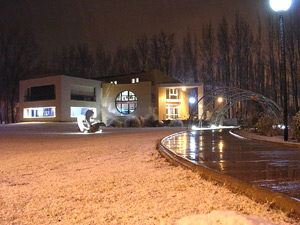Cosmic Frontier
Pierre Auger

On the pampas of western Argentina, the Pierre Auger cosmic-ray observatory studies the effects of collisions of high-energy particles with Earth's atmosphere over an area of 3,000 square kilometers.
When fast-moving particles strike air molecules in the Earth's atmosphere, debris flies from the collision in what is called an air shower. Fragments hit other air molecules in a cascade that continues until the energy of the original particle is spread among millions or even billions of particles raining down on Earth. By studying these air showers, physicists can investigate the source of the original particles.
The rate at which particles with energies above 1019 electron volts fall into the Earth's atmosphere is about one per square kilometer per year. In a square kilometer of atmosphere, researchers observe only one particle with an energy of at least 5 x 1019 each century. The more energy these particles have, the less they bend and the easier it is for scientists to discover their sources. Thus, researchers must deploy detectors over vast areas to accumulate data about these events.
Researchers at the observatory detect air showers from high-energy particles entering the Southern Hemisphere with an array of 1,600 detectors. The detector stations sit about a mile apart in a triangular pattern. Each one contains a 3,000-gallon tank filled with 12 tons of pure water. The particles leave a tiny amount of light in the water, which is picked up by a light-sensitive detector. The detectors record when particles interact with the water molecules. Computers in each station measure the number of particles coming through and compare data to determine when multiple particles originate in a large air shower, which should hit several detectors at once. Each station is self-contained and operates on solar power. The grid of detectors covers an area of about 1,200 square miles, about 10 times the size of Paris.
When cosmic rays hit the atmosphere, they also emit a faint fluorescence light. On dark nights, researchers can collect data about this light as well using four stations with six telescopes each overlooking the particle detectors. Observing features of the shower, such as how deeply the particles penetrate the atmosphere, helps scientists form a better picture of the characteristics of the particles and the paths they traveled. The observatory has been taking data since 2004. Physicists plan to build a second, larger grid of detectors in the Northern Hemisphere to cover the northern sky. Together the two arrays could look for the sources of showers from cosmic rays over the entire sky.


